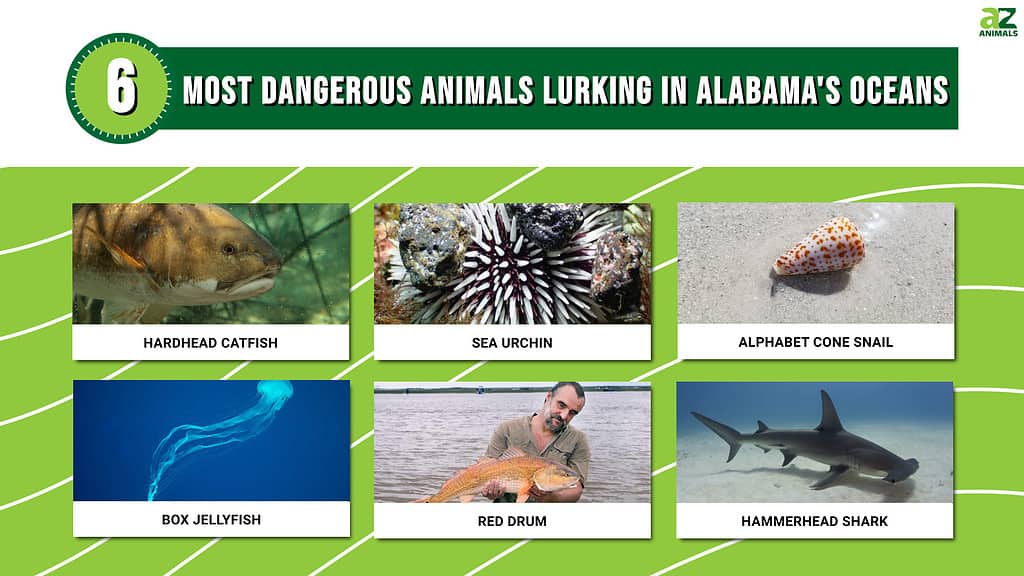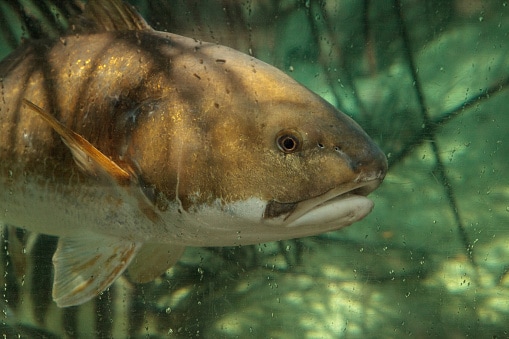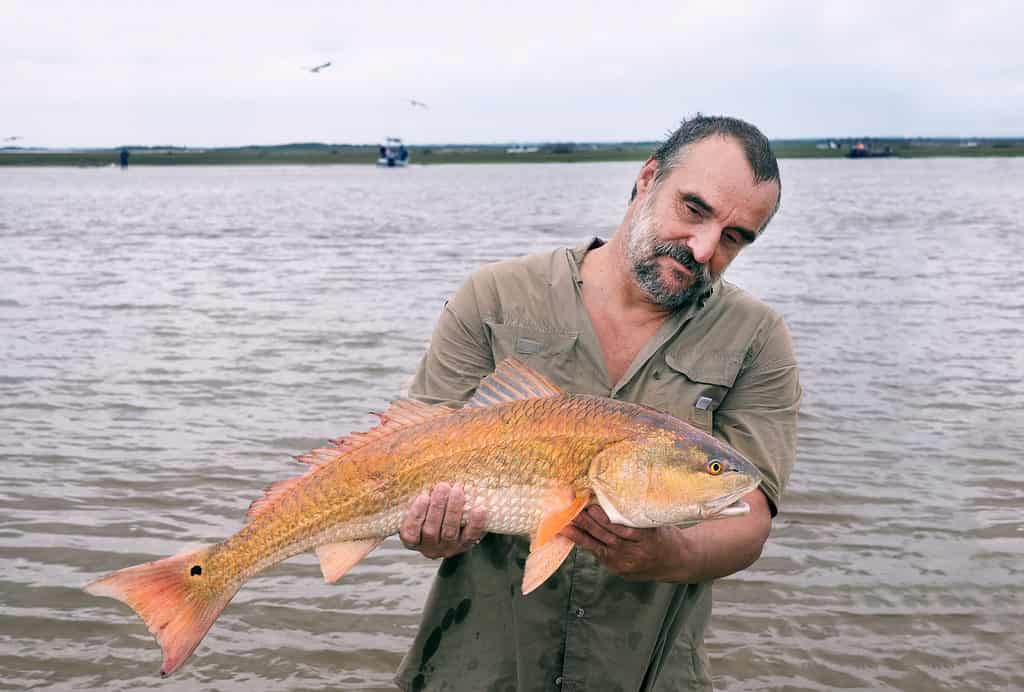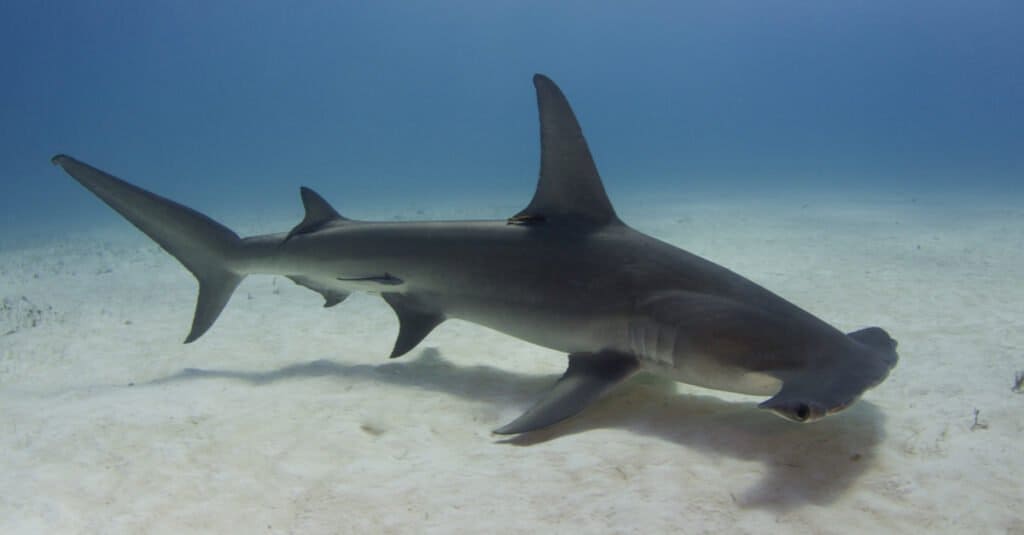Is the Gulf of Mexico Dangerous?
The Gulf of Mexico is a vast and diverse marine ecosystem that harbors a wide range of species, including some potentially dangerous animals. While the presence of these creatures adds to the natural balance and beauty of the Gulf, it’s important to be aware of the potential risks they may pose. This includes dangerous animals lurking in Alabama’s oceans.

Like any body of water, the Gulf of Mexico can present hazards. However, people can minimize these risks with proper knowledge and precautions. Understanding the behavior and characteristics of the dangerous animals in these waters is crucial for ensuring personal safety.
It’s worth noting that most dangerous animals in the Gulf do not actively seek out human contact or attack on purpose. Incidents typically occur when there is accidental contact, provocation, or mistaken identity. The risks can be significantly reduced by respecting their habitats, maintaining a safe distance, and avoiding behaviors that may provoke these creatures.

The Gulf of Mexico is teeming with marine life, some of which can be dangerous if encountered.
©high fliers/Shutterstock.com
Additionally, being aware of environmental factors such as weather conditions, strong currents, and potentially harmful algal blooms can contribute to personal safety while enjoying the Gulf’s waters.
Overall, while the Gulf of Mexico does have its share of potentially dangerous animals, it remains a diverse and awe-inspiring marine ecosystem. By understanding the potential risks, practicing responsible behavior, and following recommended safety guidelines, people can enjoy the beauty and wonders of the Gulf while minimizing the chances of encountering harm.
1. Hardhead Catfish (Ariopsis felis)

Hardhead catfish can live in freshwater or brackish seawater.
©LagunaticPhoto/ via Getty Images
The Hardhead Catfish is a fascinating dangerous animal lurking in Alabama’s oceans. While this species does not attack purposefully, specific characteristics can make them potentially dangerous to humans.
The Hardhead Catfish is a medium-sized fish with a streamlined body. They possess a dark gray or bluish coloration on their upper body, fading to a lighter shade on their belly. They have a flattened head and a mouth lined with numerous small, sharp teeth. One of their most notable features is the presence of stout spines along their dorsal and pectoral fins.
They inhabit the warm coastal waters of the Gulf of Mexico. In Alabama, you can spot them in the shallow waters near the coast, including bays, estuaries, and nearshore areas.
The Hardhead Catfish is not inherently aggressive toward humans. However, their sharp dorsal and pectoral spines can pose a danger. If mishandled or stepped on, these spines can cause painful puncture wounds due to the venomous substance coating them. When threatened or stressed, the Hardhead Catfish may instinctively use their spines for defense, inadvertently causing injury to those who come in contact with them.
Human encounters with Hardhead Catfish typically occur during fishing or handling. Accidentally injuries can result from contact with the catfish’s spines if not appropriately handled. The spines can cause puncture wounds, leading to pain, swelling, and sometimes infection. It is essential to exercise caution when removing fishing hooks or handling these catfish to minimize the risk of injury.
2. Sea Urchin (Lytechinus variegatus)

There are different species of Sea Urchins. The species most commonly found off the coast of Alabama is
Lytechinus variegatus.
©Oakland Images/Shutterstock.com
The Sea Urchin inhabits the coastal waters of the Gulf of Mexico.
Sea Urchins have a spherical body covered in a hard exoskeleton known as a test. Long, sharp spines cover the test, radiating from the center of the body. These spines act as a protective mechanism and come in various colors, such as purple, red, or green. Sea Urchins have a mouth on the underside of their body and use their spines for locomotion and defense.
You can find Sea Urchins in the coastal waters along Alabama. They inhabit shallow rocky areas, coral reefs, and seagrass beds. These habitats provide them with protection and a source of food.
The Sea Urchin’s spines are its primary defense mechanism. They are sharp and can cause painful puncture wounds if stepped on or accidentally touched. The spines can break off and remain embedded in the skin, increasing the risk of infection. Other species of Sea Urchins also possess venomous pedicellariae, which are small pincer-like structures located between the spines. These pedicellariae can cause additional irritation and injury if touched.
Human encounters with Sea Urchins typically occur when wading or swimming in shallow waters. Accidentally stepping on a Sea Urchin or brushing against its spines can result in puncture wounds and intense pain. The broken spines can be difficult to remove, and medical attention may be necessary to prevent infection.
It is important to be cautious when exploring rocky areas, coral reefs, or seagrass beds to avoid coming into contact with Sea Urchins. Wearing protective footwear or using tools to handle them, if necessary, can help minimize the risk of injury.
3. Alphabet Cone Snail (Conus spurius)

The alphabet cone snail can inject venom if threatened.
©David Johnson/ via Getty Images
The Alphabet Cone Snail is an intriguing animal found in the coastal waters of the Gulf of Mexico. It has a fascinating physical feature that can be quite harmful to those who encounter it.
The Alphabet Cone Snail showcases a beautiful, cone-shaped shell with intricate patterns and colors. They have a siphonal canal extending from the shell, which serves as a breathing apparatus. The snail’s body is soft and resides within the protective shell. It has a long, retractable proboscis used for hunting prey.
You can find the Alphabet Cone Snail along the coastline of Alabama. They inhabit sandy or muddy bottoms, where they bury themselves partially or completely.
What makes the Alphabet Cone Snail dangerous is its venomous sting. The snail possesses a modified radula tooth that acts as a harpoon-like structure. When threatened or disturbed, the snail can extend its proboscis and inject venom through its harpoon into its target.
Encounters with the Alphabet Cone Snail can pose a danger if handled or stepped on. The venom injected by their harpoon can cause severe pain, swelling, and tissue damage. The venom can sometimes lead to paralysis, respiratory failure, and even death. It is crucial to avoid handling or disturbing these snails to minimize the risk of being stung.
The Alphabet Cone Snail primarily uses its venom for hunting prey, such as small fish and other mollusks. It does not attack humans intentionally; stings usually occur when the snail is accidentally touched or picked up. It is essential to approach them cautiously and maintain a safe distance to prevent potential harm.
4. Box Jellyfish (Cubozoa class)

The Box jellyfish can be dangerous due to its long and venomous.
©IMC11/Shutterstock.com
One of the most dangerous animals lurking in Alabama’s oceans is the Box Jellyfish. While this animal does not attack humans by design, it possesses certain characteristics that can cause considerable harm.
The Box Jellyfish boasts a transparent, bell-shaped body with four distinct sides, earning its name. It has numerous tentacles that hang from the corners of its bell. Specialized cells called cnidocytes line the tentacles. These cnidocytes contain venom-filled nematocysts, which are stinging cells used for capturing prey and act as a natural defense.
You can find the Box Jellyfish in the warm coastal waters along the small Alabama coastline. They prefer shallow areas near the shore, such as bays, estuaries, and nearshore habitats.
What makes the Box Jellyfish dangerous is its venomous sting. When in contact with human skin, the nematocysts on its tentacles can release venom, causing excruciating pain and skin irritation. In severe cases, the venom can lead to cardiac arrest, paralysis, and even death. The Box Jellyfish’s transparent nature makes it challenging to spot, increasing the risk of accidental contact.
The Box Jellyfish does not intentionally seek out humans to attack. Human encounters usually occur when swimming or wading in their habitats. If stung, immediate medical attention is necessary. It is crucial to exit the water if jellyfish are spotted and to wear protective clothing to minimize skin exposure.
The Box Jellyfish possesses potent venom as a defense mechanism against predators and to capture prey. While it does not actively target humans, accidental contact with its tentacles can result in a painful and potentially life-threatening sting. Respecting the presence of Box Jellyfish and being cautious when swimming in their habitats is crucial for ensuring personal safety.
5. Red Drum (Sciaenops ocellatus)

Red Drum fish is a large fish with powerful jaws and bodies.
©IrinaK/Shutterstock.com
The Red Drum is also known as Bull Redfish. It is a hardy fish species found in the coastal waters of the Gulf of Mexico.
The Red Drum is a large fish with a robust body and a reddish or bronze-colored hue, which gives it its common name. They have a blunt snout, a sloping forehead, and thick scales. The Red Drum grows on average up to 28 to 33 inches. However, some individuals can reach impressive sizes, exceeding over 50 pounds.
You can find the Red Drum along the coastline of Alabama. You can find them in a variety of habitats, including bays, marshes, and nearshore areas, often frequenting areas with sandy or muddy bottoms.
Certain characteristics of the Red Drum can make them risky in specific circumstances. Their large size and powerful jaws and bodies can result in significant injuries if mishandled or provoked. Additionally, when caught by anglers, Red Drum can exhibit aggressive behaviors and thrash around, potentially causing harm to nearby humans.
The danger posed by Red Drum to humans is typically indirect and related to fishing activities. Accidental injuries can occur if anglers mishandle the fish, especially when removing hooks or attempting to land them. Red Drum’s strong jaws and bodies can cause injury to those trying to handle them. It is crucial to exercise caution and follow proper fishing techniques when handling these fish to minimize the risk of injury.
It is important to note that Red Drum fish do not attack humans intentionally. They may exhibit defensive behaviors if they feel threatened, such as when caught on a fishing line. However, their primary focus is self-preservation rather than aggressive intent.
6. Hammerhead Shark (Sphyrnidae family)

Hammerhead Sharks are common in the Gulf of Mexico and the coastal waters of Alabama.
©Matt9122/Shutterstock.com
Finally, the last of the dangerous animals lurking in Alabama’s oceans we will explore in this article is the Hammerhead Shark.
The Hammerhead Shark is easily recognizable by its unique hammer-shaped head, known as a cephalofoil. This distinctively shaped head features eyes positioned at each end, giving the shark excellent panoramic vision. They have a streamlined body, powerful muscles, and a grayish-brown or olive coloration. Hammerhead Sharks can grow to a variety of sizes, with different species reaching lengths of 2.5 feet up to 20 feet.
You can find Hammerhead Sharks off the coast of Alabama. They are known to inhabit various marine environments, such as nearshore areas, reefs, and offshore waters. According to the Internation Union of Conservation of Nature Specific, specific species of Hammerhead Sharks, such as the Bonnethead Shark, are classified as a species of least concern.
The Hammerhead Shark’s danger to humans lies in its sheer size and power. With their strong jaws and rows of sharp, serrated teeth, they are capable of inflicting considerable damage. Their wide-set eyes provide enhanced visual acuity, allowing them to detect prey and navigate their environment effectively. While Hammerhead Sharks do not purposefully target humans, their sheer size and power make them potentially dangerous if provoked, cornered, or mistaken for prey.
Hammerhead Sharks typically do not pose a threat to humans. However, accidental encounters can occur during fishing or when swimming in their habitats. In these situations, Hammerhead Sharks may exhibit defensive behaviors, such as quick movements or bumping into objects. Maintaining a safe distance and exercising caution to minimize the risk of such incidents is important. Their potential danger to humans arises from their natural behavior and the potential for mistaken identity or defensive reactions when they feel threatened.
Humans can coexist with these unique animals by respecting the Hammerhead Shark’s space, adhering to responsible fishing practices, and practicing awareness while swimming in their habitats.

Gulf Shores, Alabama, offers white sand and turquoise waters, but be aware of potential dangers.
©Pugalenthi Iniabarathi/Shutterstock.com
Conclusion
Plentiful marine life thrives in the Gulf of Mexico and the coastal waters of Alabama, including several potentially dangerous animals. Understanding and respecting these creatures is vital for ensuring personal safety and preserving the delicate balance of the marine ecosystem.
Among the dangerous animals lurking in Alabama’s oceans are the Hardhead Catfish, Sea Urchins, Hammerhead Sharks, Alphabet Cone Snails, Red Drum fish, and Box Jellyfish. Each of these species possesses unique characteristics that may pose risks to humans if mishandled, provoked, or accidentally encountered.
Although not aggressive, Box Jellyfish have venomous tentacles that can deliver painful stings if touched. Cone Snails possess venomous spines or harpoons, making them potentially dangerous if mishandled.
In addition, the Hardhead Catfish, Red Drum fish, Sea Urchins, and Hammerhead Sharks have physical attributes that can cause harm. The Hardhead Catfish has sharp spines that can cause painful puncture wounds if mishandled. In contrast, Sea Urchins have spines that can pierce the skin and cause injuries if stepped on or touched accidentally. Red Drum fish are incredibly hardy and robust, which can pose a danger to humans who handle them. Although not aggressive toward humans, Hammerhead Sharks can pose a risk if provoked due to their sharp teeth and powerful jaws.
It is essential to remember that these animals do not attack humans intentionally. Most incidents occur due to accidental contact, provocation, or mistaken identity. Respecting their habitats, keeping a safe distance, and following recommended safety guidelines can significantly reduce the risks associated with encountering these animals.
By fostering a sense of appreciation and understanding, humans can coexist with these remarkable creatures and witness the beauty of the Gulf of Mexico’s marine life. Responsible behavior, awareness of surroundings, and adherence to safety precautions will ensure a safe and enjoyable experience while preserving the balance of this precious ecosystem.
Summary of the 6 Most Dangerous Animals Lurking in Alabama’s Oceans
| Animal | Potential Danger | |
|---|---|---|
| 1 | Hardhead Catfish | Sharp, venom-coated spines can cause serious wounds |
| 2 | Sea Urchin | Sharp spines can cause deep puncture wounds |
| 3 | Alphabet Cone Snail | Venomous stings can cause severe pain, swelling, tissue damage, and possible death |
| 4 | Box Jellyfish | Venomous sting can cause excruciating pain, swelling, and possible cardiac arrest |
| 5 | Red Drum | Fishermen removing hooks can receive wounds from their thrashing bodies |
| 6 | Hammerhead Shark | Their powerful jaws and teeth can inflict severe damage |
Thank you for reading! Have some feedback for us? Contact the AZ Animals editorial team.








